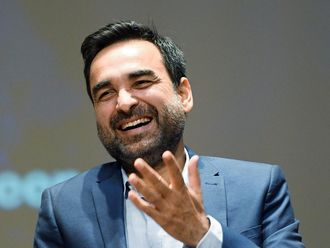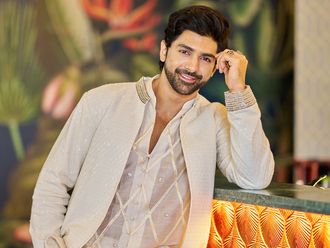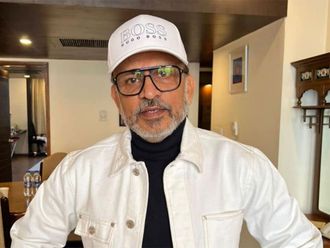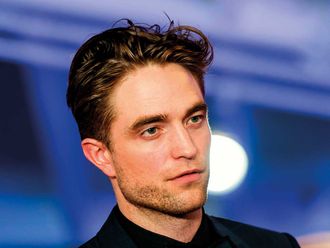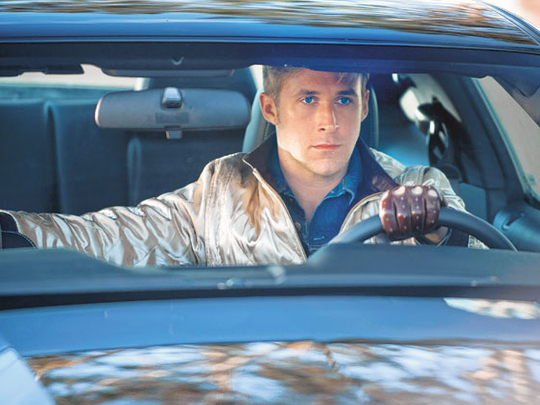
There are many ways an actor or director might unwind after a long day of shooting. Some might head for the bar; others will fall right into bed.
But when Ryan Gosling and director Nicolas Winding Refn would wrap 12 hours of shooting on Drive, their new thriller about a man who cruises around Los Angeles, they'd do the last thing you'd expect: They'd get in a car and cruise around Los Angeles.
"We would just drive for hours, talking and listening to music," Gosling, who always took the wheel, recalled as he and Refn sipped tea recently at a Beverly Hills hotel. "And I would say, ‘This is what we want to capture in the movie, this feeling of being in a trance in a car with pop music playing,'" he said, the Canadian-born Gosling telling another non-native Californian his thoughts about the very LA-drenched film they were making.
At the end of their drives, the pair would usually end up at the 101 Coffee Shop, a Hollywood eatery a few blocks from its namesake freeway. Once there, they'd talk about — what else? — driving.
A stylish and often dreamlike mood piece with flashes of a 1980s aesthetic, Drive, which opens in the UAE today, romanticises and occasionally criminalises the activity many dread most about living in LA. Inside their vehicles, characters seek peace, make escapes, find romance and commit murder.
But to say Drive is about automobiles would be like saying Rocky is about boxing rings. Over its ethereal electro-pop score, Drive probes themes of loyalty, loneliness and the dark impulses that rise up even when we try our hardest to suppress them.
Born in Denmark and raised in New York, Refn is a director of outsider genre films including the so-called Pusher trilogy, about a group of Scandinavian drug dealers, and the British-gangster biopic Bronson. Though Refn is in many ways the opposite of the much more Hollywood Gosling, the two are set to collaborate on as many as three new movies together.
In Drive, Gosling's taciturn character — known only as Driver — has a stable if isolated life. He's stuntman by day and a getaway-car driver by night, and when he's not engaging in one of those two gigs, he logs hours in the garage of a loser-ish mechanic (Bryan Cranston) or tinkers with engines and other auto parts at home.
Driver's routine is shaken up when he meets Irene (Carey Mulligan), a young mother who lives in his apartment building. The two begin a tentative but tender relationship; Driver also establishes a rapport with Irene's young son.
The idyll, inevitably, doesn't last. When Irene's semi-estranged husband is released from jail and set upon by thugs, Driver, out of a mixture of love and loyalty to Irene, agrees to help him with a robbery that will get the thugs off his back.
Soon Driver is caught up in a dangerous scheme involving a pair of ruthless gangsters (Ronald Perlman and Albert Brooks). They're the sort of characters who exact revenge by shoving forks in the eyes of those who wronged them, prompting Driver to think on his feet and often with his fists.
"I wanted to play with the classic notion of a fairy tale," Refn said. "Driver protects purity, and yet he can slay evil in the most vicious ways possible."
New perspective
The film in fact is characterised by moments of shocking violence; the movie's edginess won it plaudits at this year's Cannes Film Festival. Among its jaw-dropping scenes is a brutal beating in an elevator that makes Irene see Driver in a new light and might do the same for how audiences view Gosling.
Also upending those perceptions of the Oscar nominee is how rarely Gosling, normally known for verbally dexterous parts, actually speaks in the film. Like a vintage Steve McQueen character, Driver can go without words for minutes and never utters more than a short sentence or two at a time — an approach that Gosling said he improvised at the start of production.
"After Blue Valentine and all the press and all the talking for that movie and in that movie, I was tired of talking," the actor said, referring to his role in the 2010 romantic drama. "We also wanted to create an atmosphere of being in the car and the spell it puts you under, and talking pulls you out of that spell."
He added, "Plus Nic was listening to his iPod on set, even during takes, so the idea of talking didn't seem important anyway."
Although only 40 and with just one Hollywood movie under his belt (this one), Refn has already developed a reputation for unconventional on-set behaviour. His dynamic with his actors veers between taskmaster and Zen master.
He prodded Brooks to attack an actor in a minor role so hard that by the end of one take Brooks had the man by the neck, against a wall, causing him to collapse in a heap. "I really thought, ‘This is it. I killed him,'" Brooks recounted. "I was relieved to find out he was still alive. Then Nic told me, ‘Go again.'"
At the same time, Refn would often hug Gosling before a take for a minute or longer until Gosling submitted to it. He then communicated his approval to the actor by saying, "Go with God," and walking away.
Refn, who works mainly out of Europe and New York, decided to direct Drive because, he says, a tarot-card reader in Paris told him he would have a good experience making a film in Hollywood. So he went all in, renting a home in the Hollywood Hills and turning it into a kind of filmic Animal House. Writers lived on a top floor, editors set up a suite in the living room, and Refn's family, including his wife, two children and mother, bunked there.
Symbiosis
Even Mulligan, recently broken up from Shia LaBeouf and gripped by a sense of domestic displacement, moved in.
Although on its face a strange marriage of star and director — Gosling the swaggering wiseacre and Refn the coneheaded film nerd — the two seem to have developed a kind of symbiosis. Refn seems to like the talent and Hollywood credibility Gosling brings; the actor, in turn, grooves on Refn's film geekdom.
It's indeed hard to ignore the importance of location in this film. Much of Drive takes place in recognisable expanses of Southern California. Gosling, who for years had an apartment at 4th and Main streets downtown, said he "fell in love" with the neighbourhood and hasn't "seen it represented properly in films before".
But for all the focus on locations, the film's dominant mode is motion; cars, ultimately, are its spiritual centre. "It's one of those things you do and then you don't remember doing it," Gosling said of driving. "We wanted to capture that feeling that always seems to slip away."
When Gosling and Refn first met to discuss how to bring James Sallis' novel to the screen, things came into focus when the actor was driving the director back to his hotel. REO Speedwagon's Can't Fight This Feeling came on the radio and the two began belting out verses. They decided to depart significantly from the book, which has few actual driving sequences in it, instead creating a music-oriented movie about a man who drives around Los Angeles.
Ironically, Refn notes, he doesn't drive himself and doesn't even have a licence. But true to his persona, there's a rich and geeky explanation for that. "I'll never get a licence," he said. "Like [J.G.] Ballard in Crash, I find driving so sexual and exciting, and I'm very much aroused by speed. So I will never control a machine."
Don't miss it: Drive releases in cinemas across the UAE today.


_resources1_16a30b3d57a_small.jpg)


